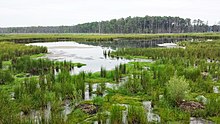

Harriet Tubman's birthplace is in Dorchester County, Maryland. Araminta Ross, the daughter of Benjamin (Ben) and Harriet (Rit) Greene Ross, was born into slavery in 1822 [1] [2] [3] [4] in her father's cabin. [2] [3] [5] [a] It was located on the farm of Anthony Thompson at Peter's Neck, at the end of Harrisville Road, which is now part of the Blackwater National Wildlife Refuge. [2] [8] [b]
Contents
After a few years, she lived on the Brodess farm with her mother and siblings. [2] [8] In the early 1840s, her father was emancipated and received 10 acres of land following Anthony Johnson's death. She was married in 1844 to John Tubman, [3] [4] at the same time, she changed her given name, becoming Harriet Tubman. [2] Realizing she was to be sold following her enslaver's death, Tubman escaped in 1849, when she was 27 years of age. [4] [8] [c] A conductor on the Underground Railroad, she made 13 return trips over 10 years to lead her parents, siblings, and friends to freedom. [4] [6]
In March 2021, archaeologists excavated what they determined to be the site of Ben Ross's cabin. They found artifacts from the 1800s, including broken dish ware, glass, a button, and nails. [2] [d] In April 2021, it was said that the site was to be added to the Harriet Tubman Underground Railroad Scenic Byway. It is a scenic drive with more than 30 stops over 125 miles. [2]